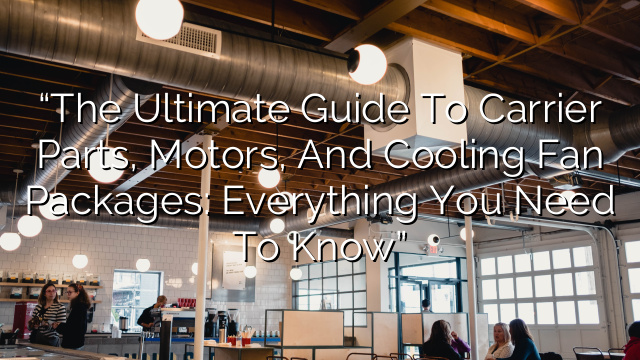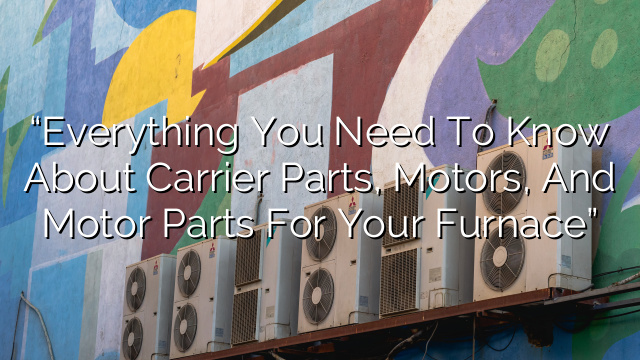Introduction
When it comes to heating and cooling systems, Carrier is known as one of the top manufacturers in the industry. They are renowned for their reliable and efficient systems that deliver exceptional performance. However, like any mechanical system, Carrier units may require occasional repairs and replacement of parts.
In this ultimate guide, we will break down the different voltage options for Carrier parts and motors. Understanding the voltage requirements is crucial to ensure that you select the right parts for your system and avoid any potential issues. Let’s dive in!
Carrier Parts and Motors
Carrier offers a wide range of parts and motors for their heating and cooling systems. Whether you need a replacement motor, blower wheel, or control board, Carrier has you covered. Before diving into the voltage options, let’s take a closer look at some popular Carrier parts and motors:
- Blower Motors: The blower motor is responsible for circulating air through the ductwork and into your living space. Carrier offers a variety of blower motors for different system models.
- Condenser Fan Motors: The condenser fan motor is located in the outdoor unit and helps remove heat from your home. Carrier offers high-quality condenser fan motors that are built to last.
- Control Boards: Control boards are the brain of your heating and cooling system. They regulate and monitor various system functions to ensure optimal performance. Carrier offers control boards for different system models and configurations.
- Capacitors: Capacitors store electrical energy in your system to provide a boost when needed. Carrier provides a range of capacitors with different voltage options to match your system’s requirements.
- Contactors: Contactors are electrical relays that control the flow of electricity to different components in your system. Carrier offers contactors with various voltage options to suit different system models.
Voltage Options
Carrier parts and motors are available in different voltage options to match the specific requirements of your heating and cooling system. Here are the most common voltage options offered by Carrier:
- 115 Volts: Many residential heating and cooling systems operate on a 115-volt power supply. Carrier provides a range of parts and motors that are designed to work seamlessly with this voltage.
- 230 Volts: Some larger residential systems, as well as commercial systems, may require a 230-volt power supply. Carrier offers parts and motors specifically designed to operate at this higher voltage.
- 460 Volts: Commercial and industrial heating and cooling systems often require a 460-volt power supply. Carrier offers a selection of parts and motors built to meet this voltage requirement.
Before purchasing any Carrier parts or motors, it’s essential to check the voltage requirements of your specific system. Installing parts with the wrong voltage can lead to system malfunction and potentially damage your equipment.
FAQs
Q: How do I determine the voltage requirement of my heating and cooling system?
A: The voltage requirement of your system is typically listed on the manufacturer’s label, which is usually located on the inside of the unit. If you’re unsure, it’s best to consult a professional technician to help you determine the voltage requirement.
Q: Can I install parts with a higher or lower voltage than what my system requires?
A: It is not recommended to install parts with a different voltage than what your system requires. Mismatched voltage can cause damage to the equipment and potentially void any warranties.
Q: Is it difficult to replace Carrier parts and motors?
A: The difficulty level of replacing Carrier parts and motors depends on the specific component and your experience with HVAC systems. Some tasks may require professional assistance, while others can be done by homeowners with basic DIY skills. It’s always best to consult the Carrier installation manual or seek professional help if you’re unsure.
Q: Where can I purchase genuine Carrier parts and motors?
A: Genuine Carrier parts and motors can be purchased from authorized dealers, online retailers, or directly from Carrier. Be cautious of counterfeit products and always verify the authenticity of the seller before making a purchase.
Conclusion
Understanding the voltage options for Carrier parts and motors is essential when it comes to maintaining and repairing your heating and cooling system. By selecting the right voltage, you can ensure optimal performance and prevent potential damage to your equipment. If you’re unsure about the voltage requirements or installation process, it’s always best to consult a professional technician to avoid any mishaps. With the right parts and proper maintenance, your Carrier system will continue to provide efficient and reliable performance for years to come.




